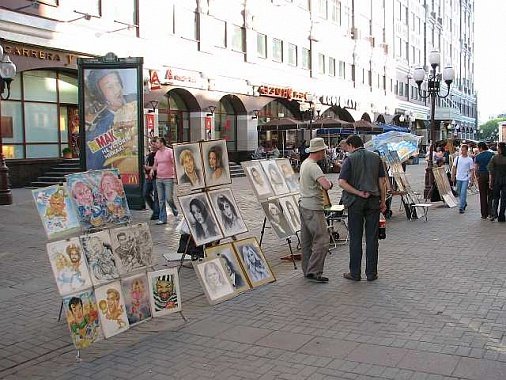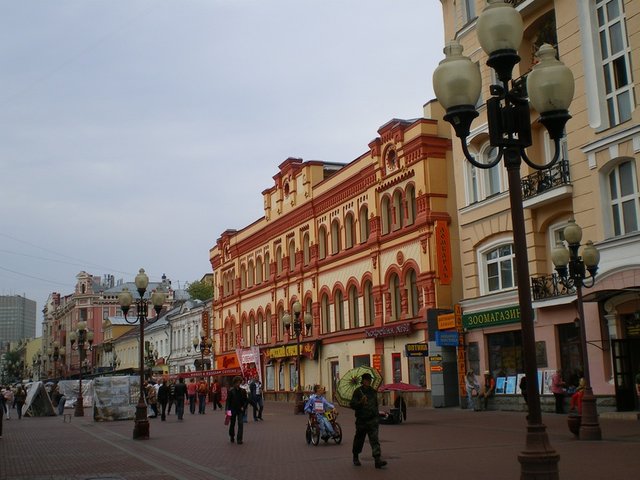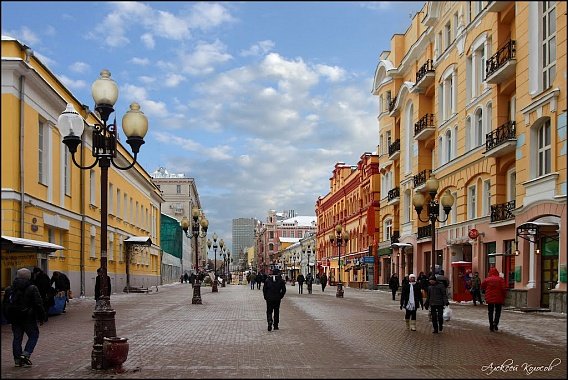The Old Arbat is a picturesque pedestrian street in Moscow, running west from Arbat Square
The Old Arbat is a picturesque pedestrian street in Moscow, running west from Arbat Square (which is part of the Boulevard Ring) towards Smolenskaya Square (which is part of the Garden Ring). The Old Arbat has the reputation of being Moscow's most touristy street, with lots of entertainment and souvenirs sold. It is distinct from the New Arbat, a street running parallel to it and lined with Soviet skyscrapers made of steel, concrete, and glass.

The first mention of the Arbat was in 1493 as a road leading from the Moscow Kremlin to Smolensk. The origin of the name is Tatar and means suburb (the same as Rabat). During the 16th and 17th centuries, the neighbourhood was graced with elegant churches, notably the one featured in Vasily Polenov's celebrated painting A Courtyard in Moscow (1879).

In the 18th century, the Arbat came to be regarded by the Russian nobility as the most prestigious living area in Moscow. The street was almost completely destroyed by the great fire during Napoleon's occupation of Moscow in 1812 and had to be rebuilt. Alexander Pushkin lodged in one of its mansions for a short time, and there is a statue of him and his wife, Natalie, in front of this house. Another famous native was the writer Andrey Bely, many of whose novels feature impressionist portrayals of this patriarchal area.
In the 20th century, the street succumbed to limited renovations in the Art Nouveau and Constructivist styles. Probably the most original monument to this new trend is the Melnikov Mansion. The street's confluence with the Garden Ring was marked with a flamboyant wedding-cake skyscraper of the Ministry of Foreign Affairs. Simultaneously, most of the Arbat's churches were demolished, including that of St Nicholas, regarded as one of the finest examples of Godunov style.
The Arbat District before the Russian Revolution.
Since 1986, the Arbat has been dotted with distinctive street lanterns. It has several notable statues, including one to Princess Turandot in front of the Vakhtangov Theatre and another to Soviet-era folk singer, bard, and poet, Bulat Okudzhava, who wrote several poignant songs about the Arbat. During Perestroika, the street was a gathering place for informal youth movements (like hippies or punks), as well as street musicians and artists. Viktor Tsoi's wall in one of the Arbat side-streets (Krivoarbatskiy Pereulok) remains a curious monument to those turbulent years. To this day, Russian youth frequently gather on the Arbat to play the songs of Tsoi and other Russian songwriters.

The Arbat is home to the headquarters of oil company TNK-BP - a modern building at the beginning of the street. It also contains numerous restaurants, including The Hard Rock Cafe. Many of these restaurants are geared towards visitors to Moscow and are considered by many residents to be over-priced and of low quality compared to those in other parts of the city. There are also a few restaurants and cafes that cater to the working population and middle class; these include Kruzhka, Praim, and Mu-Mu's.